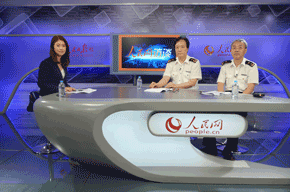 Online Interview
Online Interview
Topic: Beijing-Tianjin-Hebei Customs Clearance Integration Measures
Time:09:00 AM (Fri) June 27, 2014
Special Guests:XIE Jinyong, Deputy Director General and Party Leadership Group Member of Beijing Customs District, and ZHAO Weizhen, Director of Customs Supervision and Clearance Department of Beijing Customs District
Beijing-Tianjin-Hebei Customs Clearance Integration Measures
[Host]: Hello, netizens, welcome to the video interview at www.people.cn! From July 1 this year, the Customs authorities in Beijing, Tianjin and Hebei will gradually put into practice the reform measures for their regional clearance integration. To help explain the reform, we have two experts with us here, Mr. Xie Jinyong and Mr. Zhao Weizhen, both Directors of Beijing Customs District. [09:06]
[Xie Jinyong]: Hello, netizens. [09:07]
[Zhao Weizhen]: Hi, everyone. [09:07]
[Host]: First, Mr. Xie, could you please brief this reform for regional clearance integration? [09:09]
[Xie Jinyong]: OK. On the whole, the regional clearance integration among the Customs authorities in Beijing, Tianjin and Hebei is an important step taken by China Customs to carry out the instructions made by Party Secretary General Xi Jinping on coordinated development between Beijing Municipality and Tianjin Municipality and on Beijing-Tianjin-Hebei coordinated development.[09:10]
[Xie Jinyong]: In May 2013, Secretary General Xi Jinping, during his field trip in Tianjin, put forward the idea to reshape co-development between Beijing and Tianjin on the background of socialist modernization. In August 2013, Xi proposed to push the coordinated development among Beijing, Tianjin and Hebei Province. In February 2014, he put forward seven specific requirements for Capital Economic Rim integration. It has become a national strategy to create a new Capital Economic Rim. Therefore, the GACC has required Beijing, Tianjin and Shijiazhuang Customs Districts to further research into the integration of their customs services and also listed such an integration as an important reform task of this year at the 2014 National Conference of Customs Directors. [09:10]
[Xie Jinyong]: Through the joint research by Beijing, Tianjin and Shijiazhuang Customs Districts and relevant GACC departments, the Scheme For Regional Clearance Integration Among The Customs Authorities In Beijing, Tianjin & Hebei was made and submitted to the GACC, approved in April, and will be formally implemented in Beijing and Tianjin from July 1 and extended to Shijiazhuang by October. [09:11]
[Xie Jinyong]: The basic idea of this reform is to provide advantage integration, resource integration, specialized division of labor to customs supervision and services of the three Customs Districts, breaking regional administrative boundaries. By establishing a regional clearance center, a unified declaration platform, a risk control platform, a professional document-check platform and an on-site operating platform (shortly called “One Center and Four Platforms”), we are able to allow enterprises to independently choose the locations for customs clearance, tax payment and goods inspection and to achieve efficient enforcement of law and seamless link of services. The reform will be beneficial to trans-regional movement of production factors and to the decisive role of market in resources allocation, thus better promoting the coordinated economic development among Beijing, Tianjin and Hebei. [09:11]
[Xie Jinyong]: In the integration mode, the three Customs Districts will unify their operation specifications, processes, and law enforcement standards, and enterprises will receive the same treatment from any of the customs there they choose to go through the formalities, just like in one customs. The integration will greatly reduce the customs examination formalities, clearance links, and the cost of clearance across customs districts. By estimate, the general saving will be 20%-30%, the logistics cost will be cut by 20%-30%. Through the reform, not only the Capital International Airport, Tianjin Xingang Port, Caofeidian Port, Jingtang Port, Qinhuangdao Port and other logistic hubs will seamlessly link their customs clearances together, but also the special customs-controlled areas and bonded supervision premises in the three districts will coordinate with each other to lead bonded goods to free movement, thus providing better customs services for regional reasonable industrial distribution and upstream-downstream link. [09:12]
[Host]: Thank you, Director Xie. Will you please introduce the highlights of the regional clearance integration? [09:12]
Quick Links







